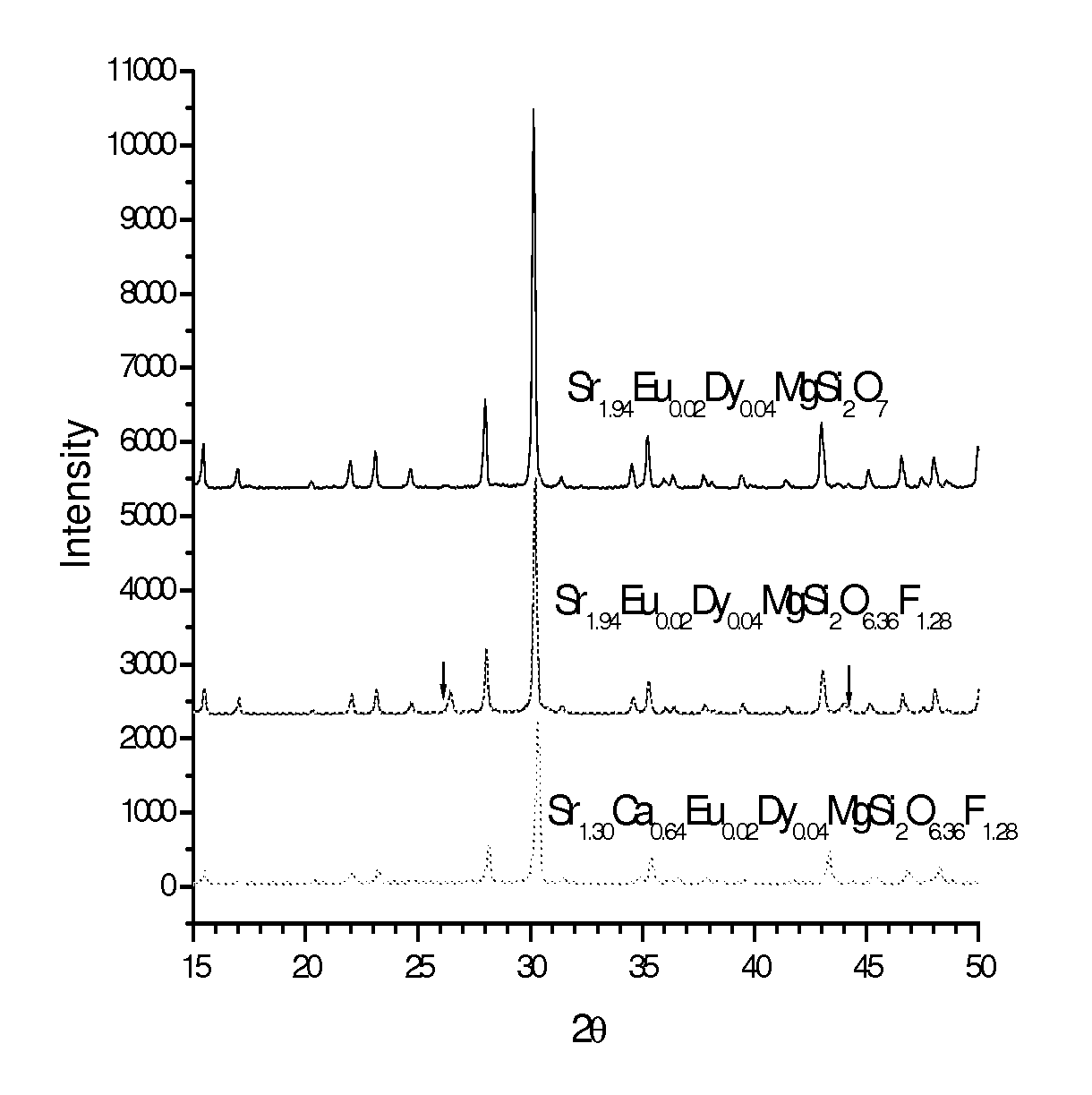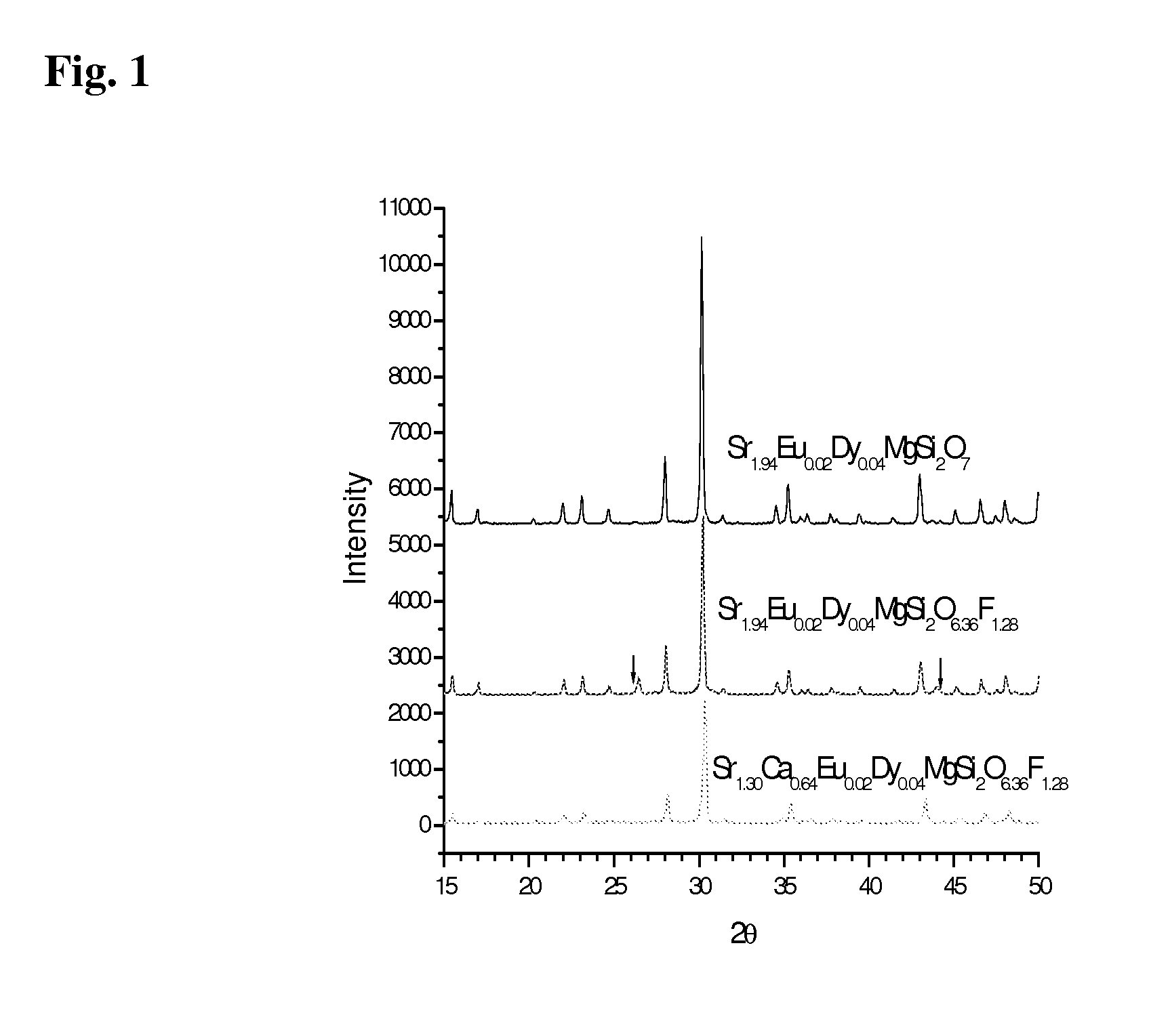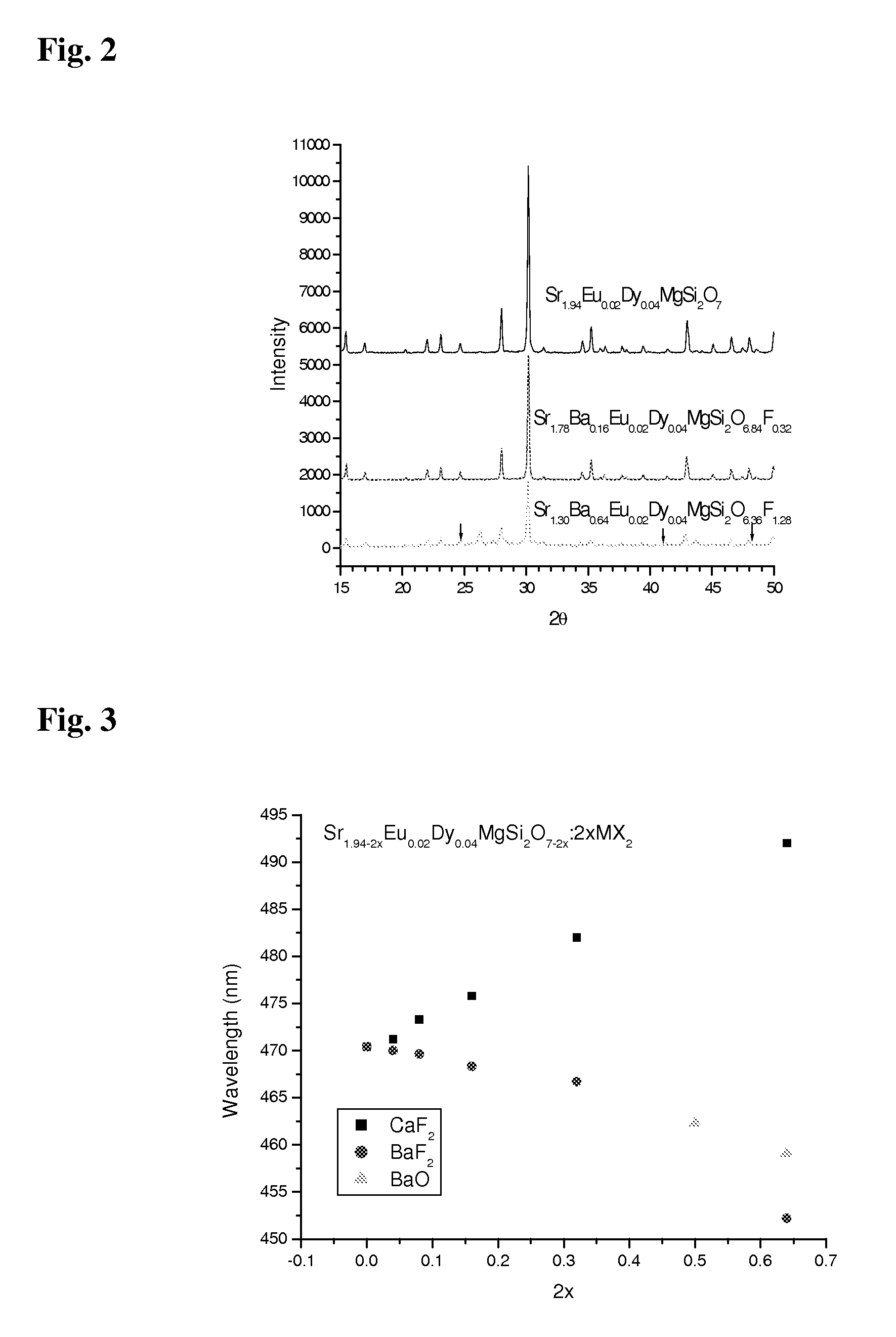Persistent phosphors of alkaline earths modified by halides and 3d ions
a technology of alkaline earths and phosphors, applied in the field of inorganic luminescent compositions, can solve the problems of reducing the energy required for crystal growth and ultimately quenching the output of finished products
- Summary
- Abstract
- Description
- Claims
- Application Information
AI Technical Summary
Problems solved by technology
Method used
Image
Examples
example 1
[0040]In a first example, the base phosphor Sr2MgSi2O7:EuDy was used with incorporation of MF2. More specifically, and as described by the chemical formulae Sr1.94-xEu0.02Dy0.04MgSi2O6.96:xMF2 with M=Sr,Ca and Ba, according to the following recipe:
(1.94−x) SrCO3+xMF2+MgO+2SiO2+0.01Eu2O3+0.02Dy2O3+0.04H3BO3
With M=Sr,Ca and Ba and x=0, 0.04, 0.08, 0.16, 0.32, 0.64. For MgF2, the following recipe was used:
1.94 SrCO3+(1−k)MgO+kMgF2+2SiO2+0.01Eu2O3+0.02Dy2O3+0.04H3BO3
[0041]where k=0, 0.04, 0.08, 0.16 or 0.64.
[0042]Generally, all of the chemicals used for fabrication have purity levels that exceeded ninety nine percent. Boric acid (which can be replaced by B2O3) was used as a flux. The chemicals were weighed according to the recipes, then mixed, ground and loaded into alumina combustion boats, pre-sintered (may not be necessary if the mixture is uniform enough) at about 900 degrees Celsius in air for about four hours, and then ground again. The samples were finally sintered at about 900...
example 2
[0046]In a second example, phosphors with incorporation of chlorides, 0.04MCl2 (M=Sr, Ca, Ba) were produced:
1.90 SrCO3+0.04MCl2+MgO+2SiO2+0.01Eu2O3+0.02Dy2O3+0.04H3BO3
For embodiments where M=Mg, the following recipe was used:
1.94 SrCO3+0.96MgO+0.04MCl2+2SiO2+0.01Eu2O3+0.02Dy2O3+0.04H3BO3
[0047]Chlorides of alkaline earths have much lower melting temperatures than their oxides. Therefore, they can be used to promote “self-fluxing” thus resulting in improved chemical reactions and crystallinity. For the case where M=Sr, the ingredients used were as follows: 3.5061 gm SrCO3, 0.1332 gm SrCl2. 6H2O, 0.5037 gm MgO, 1.5021 gm SiO2, 0.0440 gm Eu2O3, 0.0932 gm Dy2O3 and 0.0309 gm H3BO3. The chemicals were mixed, ground, pre-sintered at about 900 degrees Celsius for about four hours and ground again. This mixture was finally sintered at about 1,200 degrees Celsius for about four hours in a slightly reducing flow of hydrogenated nitrogen gas (N2+5% H2). The emission and excitation spectra are...
example 3
[0049]In a third example, deep blue phosphors were fabricated. In practical applications, some deep blue phosphors emitting at 460 nm are required. For this purpose, the following recipes were tested.
[0050]a. 1.40SrCO3+0.54BaF2+MgO+2SiO2+0.01Eu2O3+0.02Dy2O3+0.04H3BO3,
[0051]b. 1.40SrCO3+MgO+0.50BaCO3+0.04BaF2+2SiO2+0.01Eu2O3+0.02Dy2O3+0.04H3BO3.
[0052]The ingredients for the first recipe were: 2.5836 gm SrCO3, 1.1836 gm BaF2, 0.5037 gm MgO, 1.5021 gm SiO2, 0.044 gm Eu2O3, 0.0932 gm Dy2O3, although it is considered that the boric acid was not actually necessary. For the second recipe, the amount of BaF2 is replaced by 1.2333 gm BaCO3 plus 0.0879 gm BaF2. The preparation procedures are similar as in the case of example 1, except the first recipe for which the pre-sintering temperature is around 800 degrees Celsius and final sintering temperature is about 900 degrees Celsius.
[0053]The emission and excitation spectra are shown in FIG. 8. The emission band for both samples is peaked at abo...
PUM
 Login to View More
Login to View More Abstract
Description
Claims
Application Information
 Login to View More
Login to View More - R&D
- Intellectual Property
- Life Sciences
- Materials
- Tech Scout
- Unparalleled Data Quality
- Higher Quality Content
- 60% Fewer Hallucinations
Browse by: Latest US Patents, China's latest patents, Technical Efficacy Thesaurus, Application Domain, Technology Topic, Popular Technical Reports.
© 2025 PatSnap. All rights reserved.Legal|Privacy policy|Modern Slavery Act Transparency Statement|Sitemap|About US| Contact US: help@patsnap.com



